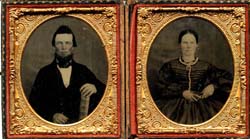 |
At first glance, this image is an almost completely standard studio portrait of a relatively prosperous Midwestern couple. They both wear respectable, if not especially expensive clothes; the large “bishop” sleeves of her dress indicate that Mrs. Van Meter kept up with the fashions of the late 1850’s. Both are well in unpretentiously groomed: she wears a bead necklace as well as rings and a brooch that the photographer has tinted gold; he has pomaded his hair. Both hold symbols of middle class respectability and culture: she a photograph case and he a book. These are all conventions of the period. On closer inspection, a single detail makes this pair more unusual. The book which Mr. Van Meter holds, W. O. Blake’s History of Slavery and the Slave Trade, Ancient and Modern, is a vast overview of the historical forms of slavery, treating the subject up to the debates over Kansas in the US Congress. It strives to maintain a certain air of objectivity, but is clearly abolitionist in its intent. Although it was common for the photographer to keep a store of books on hand as props so that customers could pose with them in order to show that they were educated, several considerations make it probable that in this case, the choice of the book was not accidental. First of all, a book on this topic, at this time in American history, would be a controversial item, and a photographer would be unlikely to keep it on hand merely as a prop, since it might offend some prospective clients. It was sold on subscription, which means that a buyer would have to go out of his or her way to buy it from the publisher or an agent. And it would be relatively expensive. Furthermore, Van Meter poses with the book clearly in view, not just lying nearby on a table. He holds it upright, close to his body, his hand cradling the top so that the title on the spine is clearly visible. He seems to want to declare that he owns this book, and that it in turn defines him in some way. In fact, it was not unusual for people having their portraits taken to bring props of their own with them to the sitting. Such a prop served as a symbol of the sitter’s occupation, or political or religious convictions, or artistic, musical or literary passions. For example, there is this portrait of two women mill workers posed with their loom shuttles and scissors {embed link to image 63 here} or this one of a man with his horn and sheet music {embed link to image 17 here}. So it is quite likely that Van Meter brought this book with him to declare his position on the great question of the day: slavery. Given the overall message of the book itself, Van Meter was probably an opponent of the institution, or possibly even an abolitionist, since he has made such a point of displaying the symbol. Commentary by Gregory Fried Bibliography: For a work on period clothing, see Joan Severa, Dressed for the Photographer: Ordinary Americans and Fashion, 1840-1900 (Kent, Ohio: The Kent State University Press, 1995). | ||

